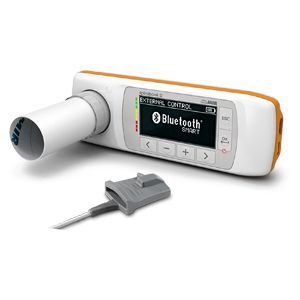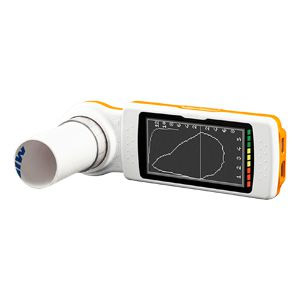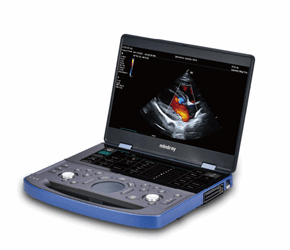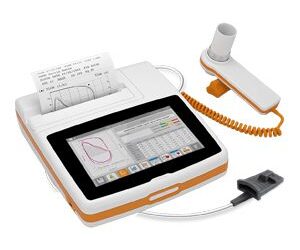In medical facilities, maintaining precise and reliable diagnostic tools is vital for patient care. Among these essential tools is the spirometer, a machine that measures lung function, helping physicians to diagnose and monitor respiratory conditions. Understanding how spirometry machines work can benefit healthcare professionals, patients, and administrators alike, especially in hospitals where these devices play a crucial role. In this article, we’ll explore the types of spirometry machines, how they work, their benefits, and considerations for healthcare providers looking to implement these tools in their facilities.
What is a Spirometry Machine?
A spirometer is a medical device that measures the volume of air inhaled and exhaled by the lungs. This test, known as spirometry, is commonly used in hospitals, clinics, and other healthcare settings to assess lung function, detect respiratory diseases, and monitor patients’ progress with lung-related treatments. Spirometers are crucial tools in diagnosing conditions such as asthma, chronic obstructive pulmonary disease (COPD), and other restrictive lung diseases.
How Does a Spirometer Work?
The basic function of a spirometer is to measure air movement in and out of the lungs. Patients breathe into a mouthpiece connected to the spirometer, which records the volume and speed of their breath. This data is then analyzed to determine lung function. Here’s a breakdown of how spirometers operate:
- Inhalation and Exhalation: The patient breathes through a tube connected to the spirometer. The device captures and measures the amount of air inhaled and exhaled.
- Recording Air Flow: The spirometer registers airflow by using sensors or a flow transducer that captures variations in pressure caused by breathing.
- Data Analysis: The machine processes the captured data, producing graphs and readings such as Forced Vital Capacity (FVC) and Forced Expiratory Volume (FEV1), which doctors use to evaluate lung health.
- Display of Results: Many spirometers are digital, meaning the results are displayed on a screen and can be saved to the patient’s medical record for future reference.
Types of Spirometry Machines
Understanding the different types of spirometers available can help medical facilities choose the best option for their needs.
1. Handheld Spirometers
- Portable and Convenient: Handheld spirometers are compact and easy to use, making them ideal for mobile testing and point-of-care diagnostics.
- Battery-Operated: Many are battery-operated, which makes them convenient for various hospital departments.
- Digital Interface: Handheld spirometers often come with a digital interface that allows for immediate viewing and recording of test results.
2. Desktop Spirometers
- Larger and More Comprehensive: Desktop spirometers are typically found in hospitals and specialty clinics. They offer a wide range of functions and are often more accurate than handheld models.
- Advanced Capabilities: These spirometers may include features like a built-in printer, software integration, and comprehensive lung function testing options.
- Ideal for Regular Testing: Due to their size and accuracy, desktop spirometers are preferred in settings where regular lung function testing is required, such as pulmonology departments.
3. PC-Based Spirometers
- Integration with Computers: PC-based spirometers connect directly to a computer, allowing healthcare providers to store data electronically for easy access and analysis.
- Software Integration: These spirometers are compatible with various software applications that enhance data interpretation and patient management.
- Comprehensive Data Analysis: PC-based spirometers are excellent for facilities that require in-depth analysis and reporting, as they can be used in conjunction with diagnostic software to create detailed reports.
 Key Features of Modern Spirometers
Key Features of Modern Spirometers
Medical facilities often seek out spirometry machines with specific features to improve patient care and streamline diagnostic processes. Here are some key attributes of modern hospital spirometers:
- Accuracy and Precision: Advanced sensors in modern spirometers allow for precise measurements, which are crucial for accurate diagnosis.
- Ease of Use: Many models feature touchscreens and simple interfaces, allowing healthcare providers to conduct tests with minimal training.
- Connectivity: Digital spirometers often include Wi-Fi or Bluetooth connectivity, enabling data to be transmitted to electronic medical records (EMRs) for easy access and monitoring.
- Battery Life: Handheld models typically offer long battery life, which is beneficial for facilities that perform frequent tests.
- Infection Control Features: Given the importance of hygiene, many spirometers are designed with disposable mouthpieces or filters to reduce the risk of cross-contamination.
What to Look for When Buying A Spirometry Machine
Cost and Budget Considerations
Budget is often one of the primary factors in purchasing decisions, and spirometry machines come in a wide range of price points. It’s important to balance cost with the features and functionalities that your facility requires.
- Initial Purchase Price: High-end spirometers with advanced features (such as full digital integration, enhanced data analysis capabilities, and real-time tracking) can be significantly more expensive than basic models. Make sure to evaluate what level of functionality you need versus what you’re able to spend.
- Total Cost of Ownership (TCO): Beyond the initial purchase cost, consider ongoing expenses like maintenance, calibration, consumables (e.g., disposable mouthpieces), software updates, and potential repairs. Calculating TCO helps avoid unexpected costs over the lifespan of the device.
- Leasing vs. Buying: For facilities that may need to upgrade equipment frequently, leasing a spirometer could be a viable option. Leasing can minimize upfront costs, provide flexibility for future technology upgrades, and often includes maintenance services.
Device Accuracy and Reliability
Accuracy is paramount in spirometry testing, as the results directly influence diagnosis and treatment plans. Assessing a device’s reliability ensures that your facility can maintain consistent testing standards and deliver dependable results.
- Validation and Certifications: Look for spirometers that meet international standards, such as those from the American Thoracic Society (ATS) or European Respiratory Society (ERS). Devices that adhere to these guidelines provide more reliable and validated results.
- Reproducibility: A reliable spirometer should deliver consistent results across multiple tests with minimal variability. If possible, request information on the device’s reproducibility metrics or ask for a demo.
- Real-Time Feedback: Some spirometers offer real-time quality control features, notifying the user if the patient’s effort is insufficient or if any error occurred during the test. This functionality helps maintain testing accuracy and saves time by avoiding the need for retests.
Integration with Electronic Health Records (EHR)
For facilities aiming to streamline patient data management, integration with Electronic Health Records (EHR) can be a valuable feature. A spirometer with EHR compatibility improves workflow efficiency and reduces the risk of errors from manual data entry.
- Seamless Data Transfer: Many modern spirometers have software or connectivity options that allow data to be directly transferred into a patient’s electronic medical record. This integration is particularly valuable in larger facilities with high patient volumes.
- Cloud Storage Options: Some spirometers provide cloud storage capabilities, enabling remote access to patient data and facilitating easy sharing among healthcare providers. Consider if this feature aligns with your facility’s needs and security protocols.
- HIPAA Compliance: Any device that stores or transfers patient data electronically must comply with privacy regulations, such as HIPAA in the United States. Be sure to verify that the spirometer’s data handling processes align with these regulations.
Portability and Space Requirements
Depending on the intended use of the spirometer, portability and space may be key considerations. Smaller facilities or those with mobile services may prioritize a device that is easy to transport and set up in various locations.
- Handheld vs. Desktop Models: Handheld spirometers are portable and convenient for point-of-care testing, while desktop models typically offer more advanced features but require a fixed setup. Consider your facility’s specific needs and space availability when choosing between these options.
- Battery Life: For mobile or portable devices, battery life is an important factor. A spirometer with extended battery life is ideal for facilities conducting high volumes of testing or operating in multiple locations throughout the day.
- Space Constraints: For facilities with limited space, a compact, tabletop spirometer may be more practical. If space is not a concern, larger desktop models with additional features can provide enhanced functionality.
 Ease of Use and User Interface
Ease of Use and User Interface
Ease of use is a significant factor that affects staff productivity and the quality of patient interactions. A user-friendly spirometer can reduce training time, improve test accuracy, and ensure smooth operation in busy environments.
- Touchscreen and Intuitive Interface: Spirometers with touchscreens and intuitive interfaces make it easier for technicians and nurses to navigate the device’s features and settings. Clear prompts and guided testing procedures can also enhance the testing experience.
- Quick Setup and Calibration: Choose a spirometer that requires minimal setup time and straightforward calibration processes. Some devices offer automated calibration, which can reduce downtime and improve workflow efficiency.
- Training Resources: Assess whether the manufacturer provides training materials, such as instructional videos or on-site demonstrations. These resources can be invaluable for ensuring that your staff can use the device effectively from day one.
Durability and Maintenance Requirements
Durability is especially important for spirometers used in high-volume facilities. Additionally, understanding a device’s maintenance needs can help you evaluate its long-term suitability and cost-effectiveness.
- Quality and Durability: Look for spirometers constructed from durable materials that can withstand frequent use and handling. Devices with robust construction and minimal wear-and-tear components are ideal for busy healthcare settings.
- Maintenance and Service Plans: Consider whether the manufacturer offers maintenance packages or extended warranties that cover regular servicing. Spirometers require routine calibration and occasional servicing to maintain accuracy, so a comprehensive service plan can help protect your investment.
- Availability of Replacement Parts: Ensure that parts like sensors and flow transducers are readily available and affordable. The ease of replacing parts is crucial for minimizing device downtime and maintaining uninterrupted service in your facility.
Compliance with Safety and Hygiene Standards
Given that spirometers involve direct patient interaction, it’s important to choose a device that meets strict safety and hygiene standards. This is particularly relevant in hospitals and clinics where infection control is a priority.
- Disposable Components: Spirometers that utilize disposable mouthpieces or filters help reduce the risk of cross-contamination between patients. Be sure to consider the cost and availability of these consumables.
- Cleaning and Disinfection Protocols: Evaluate how easy the device is to clean and disinfect. Some spirometers feature smooth surfaces and minimal crevices, making them easier to sanitize between patients.
- Certifications and Regulatory Approvals: Check that the spirometer complies with relevant healthcare standards and certifications. Devices that are FDA-approved or CE-marked for medical use are generally reliable and meet high safety standards.
Why Spirometry is Important for Medical Facilities
Implementing spirometry machines in hospitals and other medical facilities offers significant benefits:
1. Early Diagnosis of Respiratory Diseases
- Detecting COPD and Asthma: Spirometers help diagnose chronic obstructive pulmonary disease (COPD) and asthma, enabling early intervention and treatment.
- Screening for Restrictive Lung Diseases: Spirometry can also identify restrictive lung diseases, such as pulmonary fibrosis, which are otherwise difficult to detect.
2. Monitoring Patient Progress
- Assessing Treatment Effectiveness: Spirometers track how well a patient’s lungs are responding to treatment. This data is invaluable for adjusting medications or therapeutic approaches.
- Post-Surgical Monitoring: After lung surgery, spirometry can help assess recovery and detect any postoperative complications.
3. Facilitating Preventative Healthcare
- Routine Screenings: Regular spirometry testing can identify issues before they develop into serious conditions, particularly for patients with risk factors like smoking or a family history of lung disease.
- Educational Opportunities: Spirometry tests allow healthcare providers to educate patients on their lung health, encouraging lifestyle changes that could improve their overall wellbeing.
How to Choose the Right Spirometry Machine for Your Facility
When selecting a spirometer for your medical facility, consider the following factors:
1. Purpose and Frequency of Use
- General or Specialized Testing: Determine whether the spirometer will be used for routine screenings or specialized testing in pulmonology or respiratory departments.
- Volume of Patients: For high patient volume, a durable, multi-functional spirometer may be more suitable.
2. Data Storage and Connectivity
- Electronic Medical Record Integration: Look for spirometers that allow easy data transfer to EMRs to streamline patient records.
- Cloud-Based Storage: Some spirometers offer cloud storage options, allowing facilities to store and access data remotely.
3. Cost and Maintenance
- Budget Constraints: Handheld spirometers are often more affordable, whereas desktop models may offer more features but come with a higher price tag.
- Maintenance Requirements: Consider how often the device will need calibration and whether it requires specific parts, such as disposable mouthpieces or filters.
Spirometry Testing: What to Expect During the Procedure
To better understand the procedure, here’s a step-by-step overview of what a spirometry test entails:
- Preparation: The patient is seated, and a healthcare provider explains the process. The patient may be instructed to wear a nose clip to ensure that all air is exhaled through the mouth.
- Breathing Test: The patient takes a deep breath, places the mouthpiece in their mouth, and exhales forcefully into the spirometer. This process may be repeated to ensure accuracy.
- Analysis: The spirometer measures various lung capacities, such as the FEV1 and FVC, which provide insight into the patient’s lung function.
- Results: After the test, the results are displayed and analyzed by a healthcare provider, who will discuss them with the patient.
Common Uses of Hospital Spirometers
Spirometers are used in numerous medical settings, often with specific purposes related to patient care and health assessments. Below are a few common applications:
- Routine Health Screenings: Many facilities conduct spirometry tests as part of routine health screenings, especially for high-risk individuals.
- Pulmonary Rehabilitation Programs: Spirometry is essential in managing chronic respiratory diseases and forms a core component of pulmonary rehabilitation programs.
- Pre- and Post-Operative Assessments: Before and after surgeries, especially those involving the chest, spirometry helps assess lung function and aids in recovery monitoring.
Benefits of Using Spirometry Machines in Hospitals
Spirometry machines offer numerous advantages for healthcare facilities, including:
- Non-Invasive Testing: Spirometry is a non-invasive procedure, making it safe and accessible for a wide range of patients.
- Fast and Efficient: The test is quick, often taking less than 10 minutes, allowing medical facilities to perform multiple tests in a short period.
- High Diagnostic Value: Spirometry provides valuable insights into lung function, which can guide treatment and management decisions for respiratory conditions.
The Value of Spirometry in Medical Facilities
Investing in spirometry machines can improve patient outcomes by enabling early detection of respiratory issues, monitoring treatment effectiveness, and facilitating preventative care. These devices are a cornerstone of pulmonary diagnostics, providing critical information that helps healthcare providers make informed decisions. Whether your facility is considering handheld, desktop, or PC-based models, understanding the technology and choosing the right spirometer can enhance the quality of care and patient experience.
Embracing spirometry as part of a comprehensive respiratory health program supports better clinical outcomes and demonstrates a commitment to advanced healthcare solutions in the ever-evolving field of respiratory medicine.














